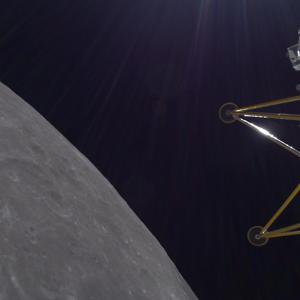A robotic lander called Athena has ceased operations after landing sideways in a crater near the moon’s south pole. This event unfolded on Thursday afternoon.
Intuitive Machines, the Texas-based company that developed Athena, announced on Friday that the mission has officially ended. Athena missed its intended landing spot by over 800 feet and toppled over.
“The mission has concluded, and our teams are reviewing the data collected during the flight,” the company stated.
This was Intuitive Machines’ second lunar landing attempt in a year. Athena stands 15 feet tall and shares a design similar to Odysseus, another lander that successfully touched down in February 2024. Notably, Odysseus also fell over shortly after landing.
NASA confirmed Athena’s touchdown at around 12:30 p.m. ET on Thursday. At a press conference later that day, Intuitive Machines’ CEO Steve Altemus explained that the team was uncertain about Athena’s exact landing site and described the result as “off-nominal,” meaning it did not go as planned.
Athena was tasked with landing on Mons Mouton, a flat-topped mountain located roughly 100 miles from the lunar south pole. Successfully landing there would have marked the closest approach to the south pole so far. The lander was equipped with a drill aimed at finding frozen water and analyzing lunar soil.
This week saw another U.S. spacecraft, SpaceX’s Starship, encountering difficulties as it lost contact shortly after launch, resulting in an explosion during a test flight.
What Did Athena Aim to Achieve?
Athena was set to deploy a rover known as the Mobile Autonomous Prospecting Platform (MAPP). This four-wheeled vehicle was designed to test cellular communications and create a 3D map of the moon’s surface. If successful, MAPP would have become the first American robotic rover on the moon.
“Lunar Voyage 1 is about more than exploration; it’s about showcasing that private companies can thrive on the moon,” said Lunar Outpost CEO Justin Cyrus. The goal is to establish lunar infrastructures and pave the way for future human presence beyond Earth.
Athena also planned to release a small robot called Gracie, intended to search for water on the lunar surface.
One of Athena’s most important components was NASA’s PRIME-1 experiment, a drill designed to dig into the moon’s crust and examine soil for water ice. This data would help scientists understand lunar resources better.
Finding evidence of water could be a significant step for NASA as it prepares to send more astronauts to the moon as part of the Artemis program, which aims to use the moon as a testing ground for future Mars missions.
“The main goal is Mars,” said retired NASA astronaut Steven Swanson, highlighting the moon’s role as a proving ground for challenges encountered in deep space exploration.
Another Lunar Mission Touchdown This Week
Firefly Aerospace, another Texas-based company, successfully landed its Blue Ghost lander on the moon earlier this week. This marked their first lunar mission, achieved with support from NASA’s Commercial Lunar Payload Services program. Since its landing, Blue Ghost has been sending back photos and data from its lunar experiments.
Source link
Intuitive Machines, Athena, Lunar Outpost, landing, lunar lander


